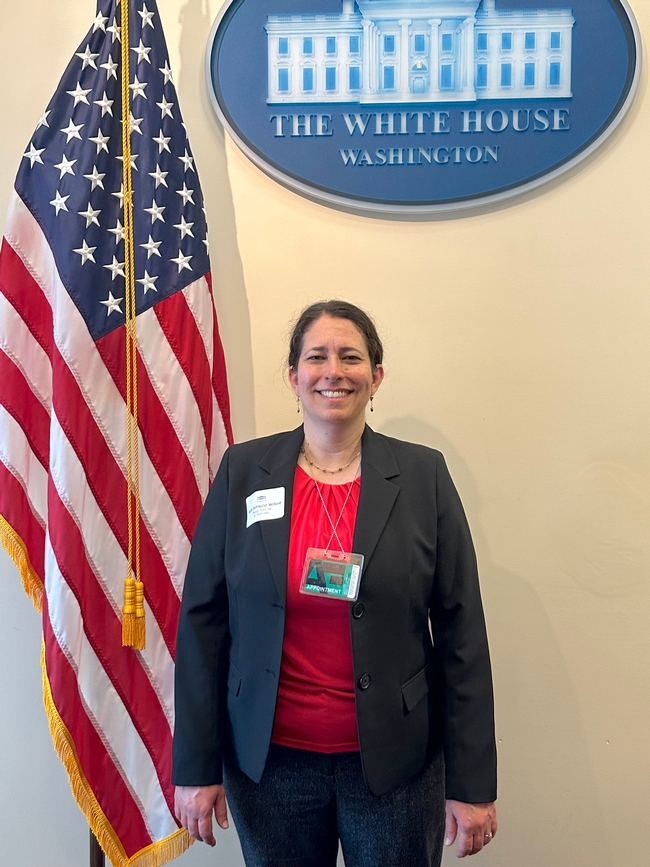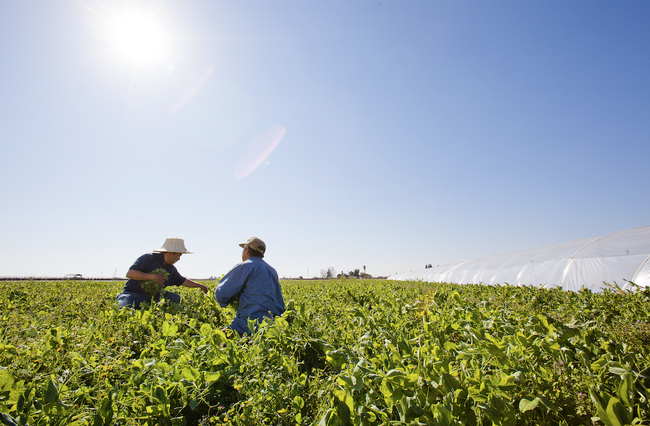
Posts Tagged: house
For the Love of Insects
How many kids have you seen running and screaming every time they encounter an insect? Maybe not...

Thea Schmidt, 4, of Folsom points excitedly to the tenants of the live petting zoo at the Bohart Museum of Entomology. (Photo by Kathy Keatley Garvey)

Thea Schmidt, 4, delights in holding a stick insect in the Bohart Museum of Entomology's live petting zoo. (Photo by Kathy Keatley Garvey)

Elliot Sauder, 7, and his sister Sutton, 9, of Sacramento are eager to look at a butterfly specimen under a microscope at the Bohart Museum of Entomology. (Photo by Kathy Keatley Garvey)

Elliot Sauder, 7, peers at a specimen under a microscope. (Photo by Kathy Keatley Garvey)
What's More Fun Than Netting a Butterfly?
What's more fun that netting a butterfly? Netting two (or more) butterflies. UC Davis doctoral...

Braden Nguyen, 3, of Davis, stretches to net a paper butterfly tossed by UC Davis doctoral student Christofer Brothers at the Bohart Museum of Entomology open house. (Photo by Kathy Keatley Garvey)

Eighteen-month-old Owen Nguyen of Davis checks out a vial holding a bug. At right is UC Davis doctoral candidate Christofer Brothers. (Photo by Kathy Keatley Garvey)

Future entomologists? The Nguyen brothers of Davis--Branden, 3, and Owen, 18 months old--pose with UC Davis doctoral candidate Christofer Brothers. (Photo by Kathy Keatley Garvey)

Owen Nguyen, 18 months old, looks at a bee vacuum at the Bohart Museum of Entomology open house. Scientists use these to capture, identify and release bees. (Photo by Kathy Keatley Garvey)
Paying Tribute to Richard 'Doc' Bohart
"His eyes seem to be following us everywhere." So quipped UC Davis distinguished professor emerita...

Only three directors have led the Bohart Museum of Entomology since 1946. Pictured are hymenopterist Lynn Kimsey, director from 1990 to Feb. 1, 2024, and arachnologist Jason Bond, director since Feb. 1. The portrait shows Richard "Doc" Bohart, who founded the insect museum in 1946. (Photo by Kathy Keatley Garvey)

A portrait of Richard "Doc" Bohart graces a wall overlooking a celebratory cake at the Bohart Museum of Entomology's Sept. 28th open house. "Doc" was born Sept. 28, 2013 in Palo Alto and founded the UC Davis insect museum, now known as the Bohart Museum of Entomology. (Photo by Kathy Keatley Garvey)

Bohart Museum director Professor Jason Bond addresses the crowd, with former director Lynn Kimsey, now a UC Davis distinguished professor emerita. Bond is the Evert and Marion Schlinger Endowed Chair, UC Davis Department of Entomology and Nematology, and associate dean, UC Davis College of Agricultural and Environmental Sciences. (Photo by Kathy Keatley Garvey)

Bohart Museum director Professor Jason Bond cuts the cake while Tabatha Yang, education and outreach coordinator serves. (Photo by Kathy Keatley Garvey)
Watch the Science of Entomology Unfold at Bohart Museum of Entomology Open House
You can watch the science of entomology unfold at the Bohart Museum of Entomology open house...

UC Davis distinguished professor emerita Lynn Kimsey, director of the Bohart Museum for 34 years until her retirement on Feb. 1, 2024, listens as the new director, Professor Jason Bond praises her at a retirement party. Bond is the Evert and Marion Schlinger Endowed Chair, UC Davis Department of Entomology and Nematology, and associate dean, UC Davis College of Agricultural and Environmental Sciences. (Photo by Kathy Keatley Garvey)

At a recent Bohart Museum open house, doctoral student Iris Quayle (left) of the Jason Bond lab and Professor Fran Keller of Folsom Lake College chat with a visitor. Keller, a UC Davis doctoral alumna, is a Bohart research associate and also a lecturer, UC Davis Department of Entomology and Nematology. (Photo by Kathy Keatley Garvey)
White House Summit explores impact of extreme heat, ways to adapt
UC ANR Small Farms Network supports small-scale and underserved farmers impacted by extreme heat
Ruth Dahlquist-Willard, interim director for the UC Sustainable Agriculture Research and Education Program, joined more than 100 participants from across the country at the first-ever White House Summit on Extreme Heat. Community representatives and practitioners met with federal agency representatives and Biden Administration officials to discuss successful locally tailored, community-driven practices to adapt to extreme heat as well as available federal resources.

In the agricultural sector, extreme heat events can cause heat illness in farmworkers, crop losses and changes in pest pressure. California crop losses due to drought, wildfire and heat were estimated at $239 million in 2023.
Disaster relief funds are available to help growers recover from lost production due to extreme heat. Since 2021, the UC ANR Small Farms Network has connected small-scale farmers with over $5.8 million in direct-to-producer relief funds for losses related to drought, flooding and other extreme weather events.
To further support small-scale farmers in adapting to the changing climate, Dahlquist-Willard and the Small Farms Network are evaluating how the extreme heat of summer 2024 impacted farmers. Farmers reported anecdotal observations that included:
- Shifting work hours to cooler parts of the day
- Closing farm stands and farmers markets due to extreme heat
- Crops ripening more quickly than expected, impacting harvesting and packing schedules
- Poor fruit set due to extremely high temperatures
The team is working to determine what damage symptoms on small-acreage California specialty crops can be attributed to extreme heat based on scientific literature and assessments from UC ANR colleagues. Understanding the impact of extreme heat on the farming community can help inform research and policy, ultimately equipping farmers with strategies to adapt to extreme heat events.
“It was inspiring to meet with leaders from around the nation who are working to support communities impacted by extreme heat and learn about the creative solutions they are implementing,” said Dahlquist-Willard. “The challenges faced by these communities make it all the more important to continue to work against climate change by reducing greenhouse gas emissions, as well as to develop new methods and resources to mitigate the effects of extreme heat and other climate impacts.”
The Extreme Heat Summit highlighted the Biden-Harris Administration's investments in climate reliance and put forth an Extreme Heat Call to Action calling upon public and private sectors to prepare for future extreme heat events. Communities and governments interested in participating are asked to use all available tools to protect people from extreme heat. Approaches and tools which could be used to protect people and resources from extreme heat are highlighted in the U.S. Climate Resilience Toolkit and the National Heat Strategy. Submissions for the Call to Action will be accepted through Nov. 1, 2024.
Further reading:
Heat Illness Prevention, UC Davis Western Center for Agricultural Health and Safety
Pathak et al., 2018. Climate Change Trends and Impacts on California Agriculture: A Detailed Review
UC's New Climate Action Goals: Frequently Asked Questions

